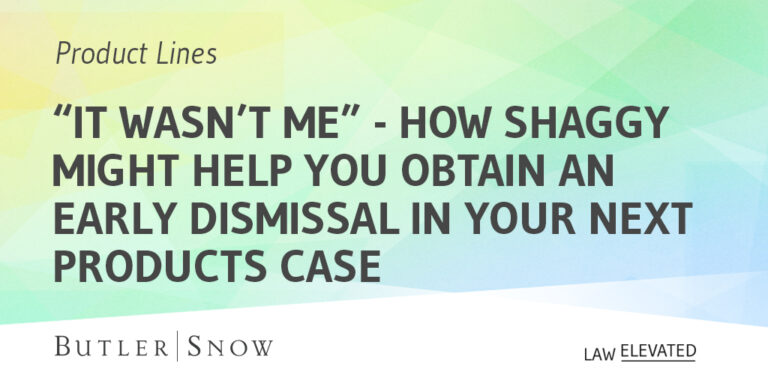Hello readers! It is with great excitement that I, [professional id=”11459″], assume the editorial reins for Product Lines from [professional id=”2345″] and [professional id=”2489″], who, along with our contributors, have done a fantastic job over the past two years of providing up-to-date commentary, insight, and analysis on key product liability and other tort matters. I will do my best to continue the great work that they began.
With that said, on to this week’s post, with which my good colleague [professional id=”12209″] has been kind enough to lend his assistance. It revolves around a recent opinion granting an early summary judgment in favor of an assembly-line robotics manufacturer and an enduring memory from law school.
The memory is of my 1L torts professor lyrically reciting the eponymous refrain from Shaggy’s 2000 triple-platinum sensation “It Wasn’t Me” during a lecture on proximate causation. The point of the reference was to highlight the defense arising from a plaintiff’s inability to establish that the defendant’s product caused the plaintiff any harm. Mildly distracting professorial vocals aside, the lesson was effective in its simplicity.
Products cases often involve complex facts. Manufacturing companies utilize overlapping systems of interrelated technologies (from a myriad of producers) in addition to human employees. Sometimes, though, quickly getting out of a case can be as simple as saying (and showing), “It wasn’t me.”
Which brings us to the recent case from the Western District of Michigan, Holbrook v. Pordomax Automation, Ltd, et al., Case No. 1:17-cv-219, where defense counsel for an assembly-line robotics manufacturer used their own version of “It Wasn’t Me” to win an early dismissal—thus saving the company the likely high cost of discovery. Wanda Holbrook worked as a robotic maintenance technician. Ventra Ionia, LLC, a non-party, used robotics to manufacture auto parts. On July 7, 2015, Ms. Holbrook was performing maintenance on one robot when another robot entered her work area and, most tragically, crushed her head, killing her.
Her estate sued a number of robotics manufacturers. Pending commencement of formal discovery, the parties agreed to make an informal inspection of the accident site. An engineer from the manufacturer in question attended the inspection and noted that none of the company’s robot products were near the accident site. Defense counsel obtained an affidavit from the engineer to that effect and used it to support an early summary judgment motion.
Predictably, the plaintiff objected to the court entertaining the motion prior to discovery. The court, however, determined that the “situation [was] one of the extraordinary circumstances where a summary judgment motion can be granted prior to formal discovery.” (ECF No. 89 at 6.) It ruled on the motion, and held that the plaintiff had “not identified any authority suggesting that a plaintiff can maintain a product liability claim when the defendant’s product was not involved at all in the accident. . . . If none of [the manufacturer’s] products were involved in the accident, [it] had no duty to [the decedent].” (Id.)
We see at least three takeaways from this case. First, remember the basics when dealing with complex cases, including “It Wasn’t Me.” Second, always be mindful of opportunities to undertake informal discovery, like a site inspection, that may create early leverage. Third, don’t be afraid to move for early summary judgment. Your rendition of “It Wasn’t Me” may never win the office karaoke contest, but it just might help terminate potentially costly litigation before it ever gets off the ground. And that is always good grounds for a mic drop.
Authored by: [professional id=”11459″] & [professional id=”12209″]
